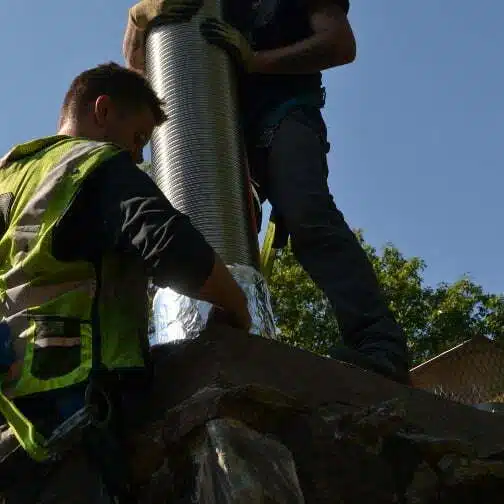chimney FAQ
Should I Install A Stainless Chimney Liner?
Short Answer: Installing a stainless chimney liner is a great option. They are safe, energy efficient, affordable, and last a long time. However, it’s best to consult a professional to assess your current chimney and discuss your options in order to make the best decision.

A chimney liner is an essential component of your home’s heating system, designed to protect the walls of the chimney from heat, fire, and corrosive gasses. It also helps to maintain proper draft, which ensures the efficient functioning of your fireplace or heating appliance. However, not all chimney liners are created equal, which brings us to the question: should you install a stainless chimney liner?
At Lindemann, we’re experts in chimney and fireplace installation and repair so we can help you determine if a stainless chimney liner is right for you. We will discuss the benefits of stainless chimney liners, considerations before installing one, and alternatives to help you make an informed decision.
The Benefits of Installing a Stainless Chimney Liner
When deciding whether to install a stainless chimney liner, you should consider the various benefits. Some of these benefits include enhanced safety for you and your family, improved energy efficiency that will lead to lower energy bills, and an extended lifespan of your chimney. Let’s take a look at these benefits.
Enhanced Safety
Installing a stainless chimney liner can significantly improve the safety of your home. A high-quality liner reduces the risk of fire by containing high temperatures and preventing heat from transferring to the surrounding combustible materials. Moreover, it helps prevent carbon monoxide, a dangerous and odorless gas, from leaking into your living space.
Improved Energy Efficiency
Stainless steel liners have excellent insulation properties, which can help maintain the optimal temperature in your chimney. This leads to better draft control, ensuring that your heating appliance operates efficiently and reducing fuel consumption.
Extended Lifespan Of The Chimney
A stainless chimney liner protects the chimney structure from corrosive gasses and moisture, preventing damage over time. It also resists damage from high temperatures, ensuring your chimney lasts longer and requires fewer repairs.
Considerations Before Installing a Stainless Chimney Liner
Now that you know the benefits of stainless chimney liners, there are some other considerations to keep in mind before making your decision. You should assess the condition of your existing chimney, choose the right size and type of liner, and budget accordingly. Let’s dive deeper into each of these considerations.
- Assess the Current Condition of Your Chimney: Before installing a stainless chimney liner, inspect your chimney for any damage or wear. If the existing liner is still in good condition and functioning effectively, you may not need to replace it.
- Choose the Right Size and Type of Stainless Liner: Selecting the proper size of the liner is crucial for optimal performance. Consult a professional to determine the correct diameter for your chimney. Also, consider whether a flexible or rigid stainless liner would be more suitable for your needs.
- Budget for Installation Costs: Consider the cost of materials and labor when planning to install a stainless chimney liner. Depending on the complexity of the installation, you may choose to do it yourself or hire a professional.
Alternatives to Stainless Steel Chimney Liners
Before deciding on a stainless liner, you should also consider the alternatives to make sure that stainless is the right choice for you. Besides stainless steel, there are also aluminum liners, clay tile liners, and cast-in-place liners. Here are some of the pros and cons of each of the choices.
Stainless Liners
As discussed earlier, stainless steel liners are energy efficient, safe, and last a long time. Stainless steel liners are typically more expensive than aluminum liners but less expensive than cast-in-place liners. The average cost for a stainless steel liner ranges from $20 to $50 per linear foot for materials. Installation costs can range from $300 to $1,500 or more, depending on the complexity of the job and labor rates in your area.
Aluminum Liners
Aluminum liners are lightweight and less expensive than stainless steel liners. They are ideal for gas appliances but are not suitable for wood or coal-burning systems due to their lower heat resistance. Aluminum liners are a more affordable option, with material costs averaging between $10 and $20 per linear foot. Installation costs for aluminum liners tend to be lower as well, ranging from $200 to $800, depending on the project’s scope and local labor rates.
Clay Tile Liners
Clay tile liners are a traditional choice for masonry chimneys. They are relatively inexpensive but can be more challenging to install and maintain. Clay tile liners are relatively inexpensive, with material costs ranging from $10 to $15 per linear foot. However, they can be more labor-intensive to install, particularly if the chimney needs modification to accommodate the tiles. Installation costs can vary widely, from $2,000 to $5,000 or more, depending on the complexity of the project.
Cast-in-Place Liners
Cast-in-place liners are custom-fit options for irregular chimneys. They provide excellent insulation and can withstand high temperatures but are more expensive than other liner options. Cast-in-place liners are a more premium option, with material costs ranging from $40 to $100 per linear foot. Installation costs can also be higher due to the custom-fit nature of these liners, with prices ranging from $1,500 to $4,000 or more, depending on the project’s scope and labor rates.
Conclusion
A stainless chimney liner offers numerous benefits, including enhanced safety, improved energy efficiency, and an extended chimney lifespan. Before installing one, assess your chimney’s current condition, choose the right size and type of liner, and budget for installation costs.
Alternatives like aluminum, clay tile, and cast-in-place liners may be more suitable in certain situations. Consult a professional at Lindemann to determine the best solution for your specific needs and enjoy the warmth and comfort of your fireplace or heating appliance with peace of mind.
